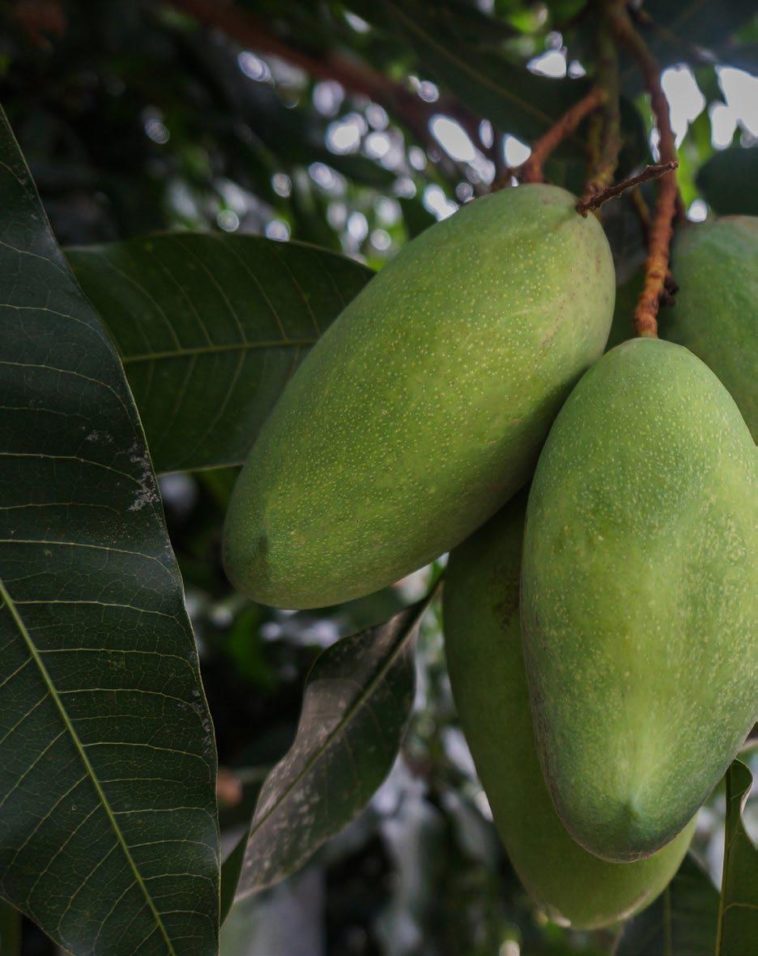Green mangoes with premature soft seeds are suitable for achar or oil pickles. Achar is very popular with a large part of the Southern African population. It is eaten with maize porridge or bread as a substitute for meat and also serves as an aromatic flavouring with other foods.
Owing to its high oil content, achar has a high nutritional value. The oil used is either mustard or ginger oil. Cured green mango slices are drained, mixed with spices and oil and filled into suitable containers and sealed. Extra oil is added on top to prevent air entry. High acid mangoes (5 to 6%) were found to produce the best quality achar.
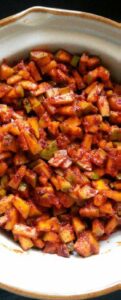
Mango achar. Photo: alishacooking.com
Harvesting of mangoes
Harvesting is the manual or mechanical removal of a food product from its natural source or parent plant. The fruit is harvested in a mature, but unripe stage, and allowed to ripen for a few days for fresh consumption or processing.
Cleaning and washing
Cleaning removes undesirable elements, removes impurities, damaged and shrunken or broken fruit and involves removal of material adhering to the surface of fruit. The fruit is washed in water-baths with brushes (large containers filled with potable water). The water must be changed regularly to minimise the chance of any contamination, and a detergent can be added, if required.
Trimming, sorting and inspection
Unwanted or unfit parts of the fruit are deliberately removed and only the best suitable raw materials are selected for manufacturing the value-added end product.
Inspection is employed to ensure that the products adhere to the minimum predetermined quality attributes required for further processing and eventual end-use.
Inspection of the products is the most labour intensive practice. The quality of the product and adherence to pre-set quality standards (colour, shape and size) must be controlled with careful inspection. The fruits should be full size, immature, with incomplete seed formation, free from diseases, scars, mechanical damage, bruises, insect damage and latex staining.
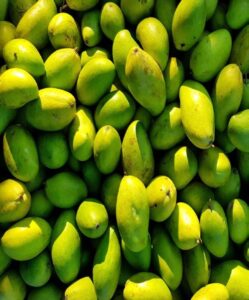
Unripe mangoes.
Washing
The fruit is finally washed with a chlorinated water spray (20 to 60 ppm active chlorine).
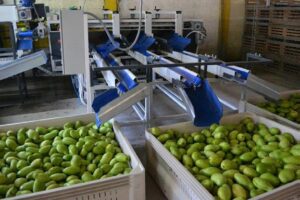
Industrial sorting of mangoes.
Peeling of mangoes (optional)
Mangoes are traditionally not peeled for achar, but can be peeled by hand with special knives or peelers if required.
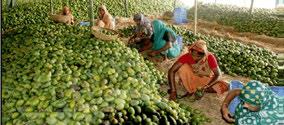
Manual inspection and sorting of mangoes.
Cutting
The flesh is quartered and cut into broad slices on a cutting board. Uniformity of size and shape is attractive in preserves and ensures even salt and spice penetration.
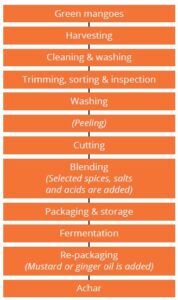
Process description for mango achar.
Blending of other ingredients
Blending is a means of dispensing additional components or ingredients uniformly into an existing food system.
The selected spice mixture (for example, 15 to 19% salt and a spice mix of 5 to 10%), preservatives permitted by legislation and citric acid permitted by legislation are mixed with the chopped mangoes.
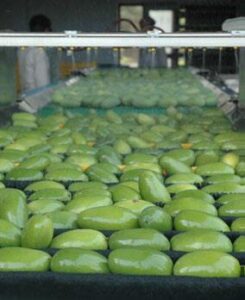
Mangoes are washed with a chlorine solution. Photo: mangomaango.com.
Packaging
Packaging is defined as the containment of a food product in a protective barrier that prepares goods for transport, distribution, storage, retailing and end-use.
The mango-spice mixture is packed into suitable containers that can be sealed hermetically.
Storage / fermentation
Fermentation is the breakdown of organic molecules under anaerobic conditions (absence of oxygen) by micro-organisms such as yeast and bacteria.
The packaged mangoes are stored for up to three months in a cool, dry place to allow for fermentation to take place.
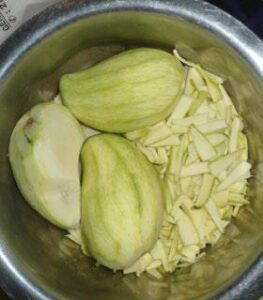
Peeled and cut pieces of green mango. Green mangoes don’t have to be peeled to make achar. Photo: wikimedia.org.
Re-packing
The achar must be re-packed after fermentation in smaller containers – suitable for individual use. Coloured oil (mustard or ginger oil) is added to the achar, to cover the product completely and prevent air entry.
Labelling of fruit preserves
The containers are labelled and coded so that the product contains all the necessary information. Products must be correctly labelled according to the requirements set out in the labelling and advertising regulations of the country.
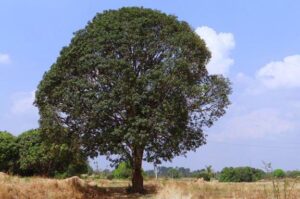
Mango tree.
Legislation for fruit products
The fruit processor should be familiar with and adhere to the laws and regulations that are applicable to the products manufactured to ensure the safe and legal marketing of a product.
Published with acknowledgement to the ARC Agricultural Engineering for the use of their manuals. Visit www.arc.agric.za for more information.
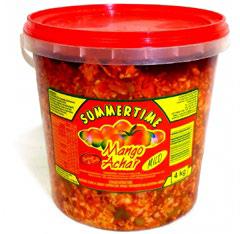
Mango achar in packaging for retail and individual use.
LITERATURE SOURCES
- Arthley, D. & Ashurts, P.R. (eds) 1996. Fruit Processing. London: Blackie Academic & Professional.
- Fellows, P. 1997. Traditional foods: Processing for profit. London: Intermediate Technology Publications, Ltd.
- Holdsworth, S.D. 1983. The preservation of fruit and vegetable food products. London: MacMillan Press.
- Kader, A.A., et al. 1985. Postharvest technology of horticultural crops. Cooperative Extension University of California.
- Mallett, C.P. 1994. Frozen Food Technology. London: Chapman & Hall.
- Nagy, S., Chen, A.S. & Shaw, P.E. (eds) 1993. Fruit Juice Processing Technology. Auburndale, Florida: AgScience, Inc.
- Raiken, M.D.; Kill, R.C. & Baker, C. (eds). 1998. Food Industries Manual, 24th ed. New York: Chapman & Hall.
- Shaw, P.E., Chan, H.T. & Nagy, S. (eds) 1998. Tropical and Subtropical Fruits. Auburndale, Florida: AgScience, Inc.
- Singh, L.B. 1968. The Mango. London: Leonard Hill:
- South Africa – Agricultural Products Standards Act (No 119 of 1990) and regulations. Pretoria: Government Printers
- South African – Foodstuffs, Cosmetics and Disinfectant Act (no 54 of 1972) and regulations. Johannesburg: Lex Patria
- Woodroof, J.G. & Luh, B.S. 1986. Commercial fruit processing. 2nd ed. Connecticut: AVI Publishing co.

